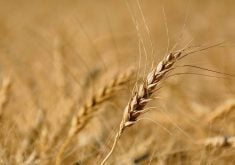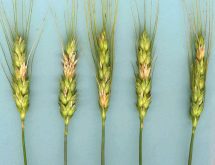For the second year in a row, winter wheat is projected to be one of the most profitable crops in Manitoba. But it won’t be as attractive this fall if last year’s crop doesn’t move soon, says Jake Davidson, executive manager of Winter Cereals Manitoba.
“My biggest concern is with the slow movement this year,” he said during an interview following Winter Cereals Manitoba’s annual meeting March 12.
“If it’s carried over demand for winter wheat in August might be a little on the thin side.”
Read Also

Mazergroup’s Bob Mazer dies
Mazergroup’s Bob Mazer, who helped grow his family’s company into a string of farm equipment dealerships and the main dealer for New Holland machinery in Saskatchewan and Manitoba, died July 6 from cancer.
The backlog in rail shipments is affecting all western Canadian crops. Last fall, winter wheat was in high demand from grain companies. If those companies don’t move most of the crop by this fall, or lose money, they might be less aggressive buyers this fall, Davidson said.
“It was a real boon (last fall),” he said. “People were getting phone calls on the combine from different companies bidding it up.”
For example, Paterson GlobalFoods purchased and piled almost 3.8 million bushels of wheat outside its Winnipeg and Morris terminals. The company just started moving it out earlier this month.
Under the Canadian Wheat Board monopoly, farmers had never delivered and sold so much winter wheat so early in the crop year, Davidson said. Meanwhile, the gap between winter and spring wheat prices has narrowed.
“As the quality (of winter wheat) gets better it is going to contend very highly,” Davidson said. “The new varieties are all excellent milling wheats.”
One of those new varieties is AC Flourish, which yields better, is shorter and has higher protein than the popular CDC Falcon. That variety moves to the Canada Western General Purpose class Aug. 1, from the Canada Western Red Winter.
Falcon is by far Manitoba’s most popular winter wheat, accounting for 84 per cent of its winter wheat acres in 2013, according to crop insurance data. However, because of its lower baking quality, the grain industry agreed to remove it from the CWRW class once a suitable replacement was available.
Davidson predicts Falcon acres will remain high in Manitoba because much of it is grown for livestock feed.
Another AAFC variety, AC Emerson, will be available from Canterra Seeds this fall. It is the first wheat of any type in Western Canada rated as resistant to fusarium head blight.
Although AC Emerson has an “R” rating, it isn’t immune to fusarium. Farmers should still take steps to mitigate the impact of the fungal disease.
Limited supplies of AC Gateway, another AAFC variety, will be available from Seed Depot under an identity-preserved program this fall. Full commercial release is expected in 2015.
Davidson estimates Manitoba farmers planted between 410,000 and 430,000 acres of winter wheat last fall — about the same number as was harvested in 2013.
In the fall of 2012, Manitoba farmers planted 615,000 acres of winter wheat, but about a third of those acres — mostly in western Manitoba — didn’t survive due to dry seedbeds followed by a tough winter.
From the Alberta Farmer Express website: Eastern ice latest obstacle to clearing grain backlog
Seeding conditions were better last fall, and while the 2013-14 winter has been colder than average many areas had good snow cover, Davidson said.
Winter Cereals Manitoba collects a 50-cent-a-tonne checkoff on winter wheat sales with most of the money raised invested in research.
“We’ve committed $300,000 or so to winter wheat research into cold hardiness and extending the seeding period,” Davidson said.
Some of that money is going to University of Saskatchewan researchers Ravindra Chibbar and Monica Baga. Their work could cut the development time of new winter wheat varieties by almost half, Chibbar told the meeting. The association is also investing funds into a Growing Forward 2 project and at the University of Manitoba.
Although Canada is famous for its high-quality spring milling wheat, most of the wheat traded and consumed in the world is the winter type.
Wheats are similar to oils used in the combine, Jim Smolik, the Canadian Grain Commission’s assistant chief commissioner, told the meeting. You don’t put transmission oil in the engine, he said.
“They all have a different functionality,” Smolik said. “That’s a thing I learned coming to the grain commission. I farmed for 32 years. Coming to the grain commission, boy, my eyes got pretty big, pretty quick.”
Asian steam buns are mainly made with winter wheat flour because of its bright, white flour, while winter and Canadian Prairie Spring wheat flours are well suited for Asian noodles, Smolik said.
About half of Canada’s wheat is exported to Asia and about 40 per cent of that goes for noodles and steam buns, returning western farmers about $1.1 billion a year, he said.
Preliminary quality research on AC Flourish and Moats, another winter wheat, showed good results, Smolik said. But he stressed since it’s based on just one year of data the findings aren’t definitive.




















